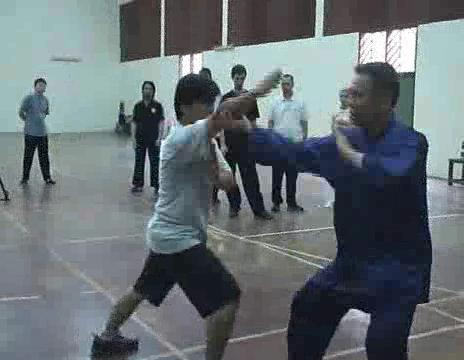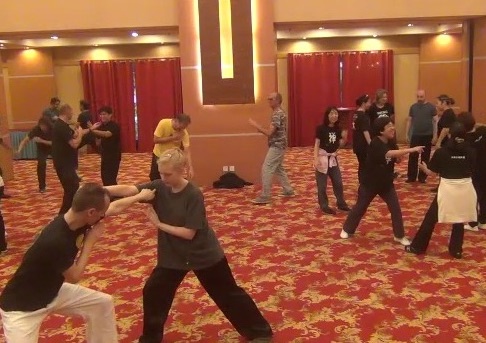CHIN-NA, DIM MARK AND NEI KUNG

Grandmaster Wong applying c chin-na technique on Sifu Wong Chun Nga
Question
You mentioned that Chin-Na is one of the three ultimates of Shaolin, the other being Dim Mark and Nei Kung. Could you explain why these three Arts are ultimate and what particularly does Chin-Na contribute to being among the others? Also what is meant by Nei Kung in this context? And finally what is the essence of Chin Na and how does the mastery of China Na become visible?
Sifu Anton Schmick
Answer
The three ultimates of Shaolin Kungfu are chin-na, dim mark and nei kung. They should not be confused with the three ultimates of martial arts, which are One-Finger Zen, Strike-Across-Space Palm and Marvelous Fist.
The use of Chinese words in Romanized letters can be problematic. “Chin-na” is in Mandarin Chinese, but in Romanized spelling it is spelt as “qin-na”. “Qi” in Romanized Chinese is pronounced like the English “ch”. We use “chin-na” and not “qin-na’ to maintain uniformity and to avoid mispronunciation, just as we use “chi kung” and not “qigong”, and “Tao” and not “Dao”. The same two words pronounced as “chin-na” in Mandarin are pronounced as “kam-na” in Cantonese.
Chin-na, dim mark and nei kung are considered the ultimates of Shaolin because of the following reasons:
- These three ultimates demand very high-level skills.
- It needs much time to develop the required skills, at least 10 years, probably 20. Please note that if a practitioner is prepared to train for 20 years, it does not mean he can develop the required skills.
- The arts are very rare, though many people may like to acquire them.
- The arts are highly valuables. Chin-na and dim mark, for example, are compassionate and effective ways of fighting; nei kung contributes to good health, vitality, longevity, peak performance, mental clarity and spiritual achievement.
Chin-na is often executed using the tiger-claw, the eagle-claw or the dragon-claw.
"Nei kung" means "internal arts", and is in Mandarin pronunciation. In Romanized Chinese it is written as "neigong". We use "nei kung", which is also widely used in kungfu literature, instead of "neigong" to avoid mispronunciation. The Romanized Chinese "g" and "o" are pronounced like the English "k" and "u", but many people may mispronounce them as the English "g" and "o".
In contrast to "nei kung" is "wai kung", or "noi kung" and "ngoi kung" in Cantonese.
One must be aware that kungfu terms and chi kung terns are unlike scientific terms. Kungfu terms and chi kung terms are used for convenience, and are not definitive, which actually means restricting. In the context here, "nei kung" refers to internal arts for internal force or for health, and not for external fighting. Here, "nei kung" refers to such practices like Sinew Metamorphosis and sitting meditation. When you use chin-na or dim mark for fighting, even when you use internal force, it is considered "wai kung" or external arts.
"Dim mark" is in Cantonese, and it means "dotting meridians". Many masters of Southern Shaolin Kungfu speak Cantonese. Cantonese is not only the prominent Chinese dialect in south China, but also in most areas when overseas Chinese have settled, like Southeast Asia, Australia, Europe and North America. So many kungfu terms are in Cantonese pronunciation. It was also in Cantonese that I learned most of the kungfu terms.
In Mandarin, dim mark is "dian xue". "Dian" means "dot", and "xue" means "energy-points'. So, there is a slight difference in meaning, represented in “mark” and “xue”. In Cantonese, the concept is dotting meridians; in Mandarin it is dotting energy points.
Both concepts are correct. Although an expert usually dots an energy point, if he dots a meridian, he will also disable an opponent from further fighting.
Dim mark is wrongly translated as a “touch of death”. It is actually a compassionate way of fighting. Although a victim of dim mark may eventually die if he is foolish enough not to relieve himself of his suffering, a dim mark injury is reversible. A dim mark victim can seek another kungfu master or competent Chinese trained doctor to restore his energy flow in his meridian and be healthy again. Western trained doctors may not be of much help because clearing energy blockage is not part of their medical training.
It was simply incredible that course participants at my Special Dragon Strength Course learned dim mark in just five days, besides learning many other things. If a master could learn dim mark in five years, he would consider himself very, very Lucky. Course participants at my Special Dragon Strength Course needed prior kungfu experience, but masters too needed many years of experience before they could become masters.
The essence of chin-na is to disable an opponent so that he cannot continue to fight but without causing him irreversible injury. There are three main ways in chin-na to disable an opponent, which are:
- Separating tendons
- Wronging joints
- Gripping vital points
Chin-na is a compassionate way of fighting. The injury, while disabling at the time, is reversible. The opponent can later seek another master or competent Chinese trained doctor to eliminate his injury and regain his normal function.
Nevertheless, when my sifu, Sifu Ho Fatt Nam, taught me chin-na, he asked me to apply wronging joints very carefully, or not at all, because if an opponent moves when a chin-na expert applies wronging joints, bits of bones at the joints may be broken off, and it will be difficult to repair the tiny fractures. By comparison, a fracture at the main bone can be repaired more easily.
The mastery of chin-na becomes visible when it is obvious the chin-na expert has accomplished his objective, i.e. the opponent cannot fight further but his injury can be relieved later.
Among the three methods of subduing an opponent, namely separating tendons, wronging joints, and gripping vital points, the most frequently used is gripping vital points. It is similar to dim mark, except that in dim mark an exponent strikes a vital point, whereas in chin-na he grips one or more vital points.
Technically, chin-na is more advanced than dim mark. To apply a dim mark successfully, which is a strike, only one movement is needed, whereas in chin-na four movements are needed. In a kick two movements are needed, and in a felling attack three movements.
You need to make only one movement in a strike. To apply a kick, you need to balance yourself, then kick. To fell an onopponent, you need to cover an opponent, secure a leverage advantage, then apply a felling technique. To apply chin-na, you need to move in, cover an opponentpo hold him, then grip his vital point
In the coming Chin-Na Course, we shall learn how to make four movements effectively before an opponent can make one. Tactics and strategies will also be used. Chin-na is not only a compassionate way of fighting, it also requires high-level skills.

Sifu Markus Kahila applying a dim mark technique during the Dragon Strength Course in 2014
The questions and answers are reproduced from the thread 10 Questions on Shaolin Chin-Na in the Shaolin Wahnam Discussion Forum
LINKS
